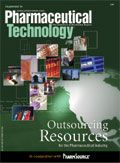Outsourcing and Competitive Advantages: Lessons from the Road
Industry must look at manufacturing as a competitive advantage, not just a way to get product out the door.
At the end of June, in Shanghai, I had the chance to talk to teams from a dozen or so Chinese manufacturers of pharmaceuticals and bulk intermediates. Every one of them told me that their goal was to make their company, and their country, the world's preferred pharmaceutical manufacturing partner. Many of these executives are returnees, bringing back some Western know-how and a Western viewpoint.

Douglas McCormick
In an interview last month, I asked FDA Deputy Commissioner Janet Woodcock, MD, what one single message she'd like to send drug manufacturers in this country. "The pharmaceutical industry," she said, "is going to have to start looking at manufacturing as a competitive advantage, not as a way just to get product out the door."
Woodcock was talking about the United States' long tradition of technical innovation, the need to return to that tradition in the manufacture of drugs, and FDA's progress towards new regulatory standards to make that possible.
But what is "advantage"? In China, where even skilled workers may earn a tenth of what they'd make in the West, the Shanghai executives were talking about meeting established CGMP quality standards at half the price of other world producers.
So, which competitive advantage do you pursue? The technological edge or the cost edge? Technology costs money and effort, and there's no guarantee that, at the end of the day, the new systems will produce the benefit in productivity or quality that you were counting on when you started. The cost edge can pay off immediately, but following that path leads to an immediate commoditization of the contract service, as competitors find their own low-cost vendors and the combined buyers relentlessly squeeze supplier profits. If it's possible to have irrational exuberance in capital markets, it's also possible to have irresponsible economy in supplier relationships.
Auto da fé. This past week, the Wall Street Journal described how automotive parts suppliers are struggling in a deeply commoditized market (1). Eleven companies—including Delphi Corp., Dana Corp., Tower Automotive Inc. and Collins & Aikman Corp.—have defaulted since 2002, according to the Journal.
Delphi, you may recall, was spun out of General Motors in 1999. In an evolution that might be familiar to the US pharmaceutical industry, the newly independent parts-maker was immediately subjected to relentless price pressure that threatened to crush it. And Delphi is not alone.
"If you squeeze the suppliers a little bit more, there may be even fewer of them left," the Journal quotes an industry analyst. "The suppliers don't produce bad parts, but they are in trouble because they have been squeezed . . . it's a sheer formula for disaster."
Innovation with outsourcing. Over the past year, I've made a point of visiting contract manufacturing facilities in the United States, too. They are very good at what they do. They are also preternaturally attuned to their clients' moods. And what their clients want, for the most part, is no-frills production at the lowest possible price . . . or, if possible, below the lowest possible price. The clients are not generally interested in financing the research and equipment that would be necessary to create the kind of flexible, innovative manufacturing systems emerging from the new US regulatory formulas.
Yet, in theory, the contract manufacturers, with multiple campaigns on multiple products and their pressured profit margins, have much to gain from adopting new technology. The question is, will the market allow them the breathing space?
Douglas McCormick is editor in chief of Pharmaceutical Technology, dmccormick@advanstar.com
Reference
1. I. Mcdonald and S. Ng, "Heard on the Street: Auto-Parts Makers May Give Clearer Picture of Industry Health—Or an Underlying Lack Thereof," The Wall Street Journal, July 20, 2006; Page C1.

Drug Solutions Podcast: A Closer Look at mRNA in Oncology and Vaccines
April 30th 2024In this episode fo the Drug Solutions Podcast, etherna’s vice-president of Technology and Innovation, Stefaan De Koker, discusses the merits and challenges of using mRNA as the foundation for therapeutics in oncology as well as for vaccines.
PacBio Chosen as Tech Partner for Global Alzheimer’s Disease Research Project
April 23rd 2025The project, the North African Dementia Registry, will unite multiple entities for the purpose of developing a comprehensive dataset to advance the research community’s understanding of Alzheimer’s disease and other dementias in diverse populations.
Drug Solutions Podcast: Gliding Through the Ins and Outs of the Pharma Supply Chain
November 14th 2023In this episode of the Drug Solutions podcast, Jill Murphy, former editor, speaks with Bourji Mourad, partnership director at ThermoSafe, about the supply chain in the pharmaceutical industry, specifically related to packaging, pharma air freight, and the pressure on suppliers with post-COVID-19 changes on delivery.